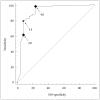Clinical Utility of an Automated Pupillometer in Patients with Acute Brain Lesion
- PMID: 26587191
- PMCID: PMC4651998
- DOI: 10.3340/jkns.2015.58.4.363
Clinical Utility of an Automated Pupillometer in Patients with Acute Brain Lesion
Abstract
Objective: The purpose of this study was to evaluate the clinical utility and validity of using a pupillometer to assess patients with acute brain lesions.
Methods: Pupillary examinations using an automated pupillometer (NeurOptics®NPi™-100 Pupillometer) were performed every 4 hours and were simultaneously assessed using the Glasgow Coma Scale (GCS) and for intracranial pressure (ICP), from admission to discharge or expire in neuro-intensive care unit (NICU). Manual pupillary examinations were also recorded for comparison. By comparing these data, we evaluated the validity of using automated pupillometers to predict clinical outcomes.
Results: The mean values of the Neurologic Pupillary index (NPi) were different in the groups examined manually. The GCS correlated well with NPi values, especially in severe brain injury patients (GCS below 9). However, the NPi values were weakly correlated with intracranial pressure (ICP) when the ICP was lower than 30 cm H2O. The NPi value was not affected by age or intensity of illumination. In patients with a "poor" prognosis who had a Glasgow Outcome Scale (GOS) of 1 or 2, the mean initial NPi score was 0.88±1.68, whereas the value was 3.89±0.97 in patients with a "favorable" prognosis who had a GOS greater than 2 (p<0.001). For predicting clinical outcomes, the initial NPi value of 3.4 had the highest sensitivity and specificity.
Conclusion: An automated pupillometer can serve as a simple and useful tool for the accurate measurement of pupillary reactivity in patients with acute brain lesions.
Keywords: Light reflex; Neurologic Pupillary Index; Pupillometer.
Figures




Similar articles
-
Quantitative pupillometry for the monitoring of intracranial hypertension in patients with severe traumatic brain injury.Crit Care. 2019 May 2;23(1):155. doi: 10.1186/s13054-019-2436-3. Crit Care. 2019. PMID: 31046817 Free PMC article.
-
Correlations Between Hourly Pupillometer Readings and Intracranial Pressure Values.J Neurosci Nurs. 2017 Aug;49(4):229-234. doi: 10.1097/JNN.0000000000000290. J Neurosci Nurs. 2017. PMID: 28661946
-
Validation of a Smartphone Pupillometry Application in Diagnosing Severe Traumatic Brain Injury.J Neurotrauma. 2023 Oct;40(19-20):2118-2125. doi: 10.1089/neu.2022.0516. Epub 2023 Aug 16. J Neurotrauma. 2023. PMID: 37464770
-
[Value of serial CT scanning and intracranial pressure monitoring for detecting new intracranial mass effect in severe head injury patients showing lesions type I-II in the initial CT scan].Neurocirugia (Astur). 2005 Jun;16(3):217-34. Neurocirugia (Astur). 2005. PMID: 16007322 Review. Spanish.
-
Automated pupillometer for monitoring the critically ill patient: a critical appraisal.J Crit Care. 2014 Aug;29(4):599-603. doi: 10.1016/j.jcrc.2014.01.012. Epub 2014 Jan 29. J Crit Care. 2014. PMID: 24613394 Review.
Cited by
-
Early Pupillometry Assessment in Traumatic Brain Injury Patients: A Retrospective Study.Brain Sci. 2021 Dec 20;11(12):1657. doi: 10.3390/brainsci11121657. Brain Sci. 2021. PMID: 34942959 Free PMC article.
-
The impact of Alzheimer's disease risk factors on the pupillary light response.Front Neurosci. 2023 Aug 15;17:1248640. doi: 10.3389/fnins.2023.1248640. eCollection 2023. Front Neurosci. 2023. PMID: 37650103 Free PMC article. Review.
-
Neurological Pupillary Index (NPi) Measurement Using Pupillometry and Outcomes in Critically Ill Children.Cureus. 2023 Oct 4;15(10):e46480. doi: 10.7759/cureus.46480. eCollection 2023 Oct. Cureus. 2023. PMID: 37927706 Free PMC article.
-
Assessing the Inter-Rater and Inter-Trial Reliability of the NeurOptics Pupillary Light Response-3000 Pupillometer.Int J Sports Phys Ther. 2025 Feb 1;20(2):157-167. doi: 10.26603/001c.128047. eCollection 2025. Int J Sports Phys Ther. 2025. PMID: 39906054 Free PMC article.
-
Characterising cerebrovascular reactivity and the pupillary light response-a comparative study.Front Physiol. 2024 Aug 8;15:1384113. doi: 10.3389/fphys.2024.1384113. eCollection 2024. Front Physiol. 2024. PMID: 39175613 Free PMC article.
References
-
- Behrends M, Niemann CU, Larson MD. Infrared pupillometry to detect the light reflex during cardiopulmonary resuscitation : a case series. Resuscitation. 2012;83:1223–1228. - PubMed
-
- Cohen LM, Rosenberg MA, Tanna AP, Volpe NJ. A novel computerized portable pupillometer detects and quantifies relative afferent pupillary defects. Curr Eye Res. 2015;40:1120–1127. - PubMed
LinkOut - more resources
Full Text Sources
Other Literature Sources
Medical

